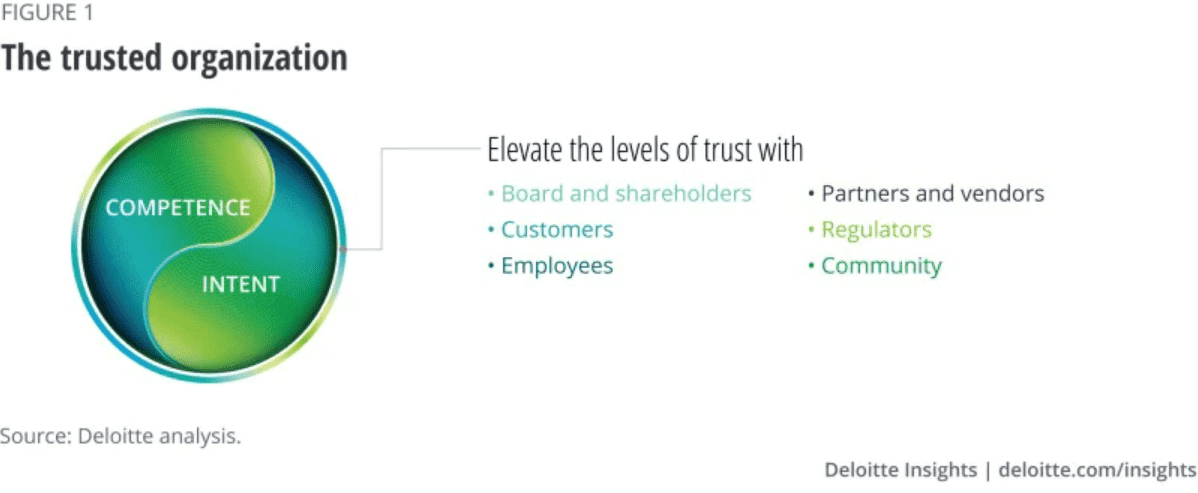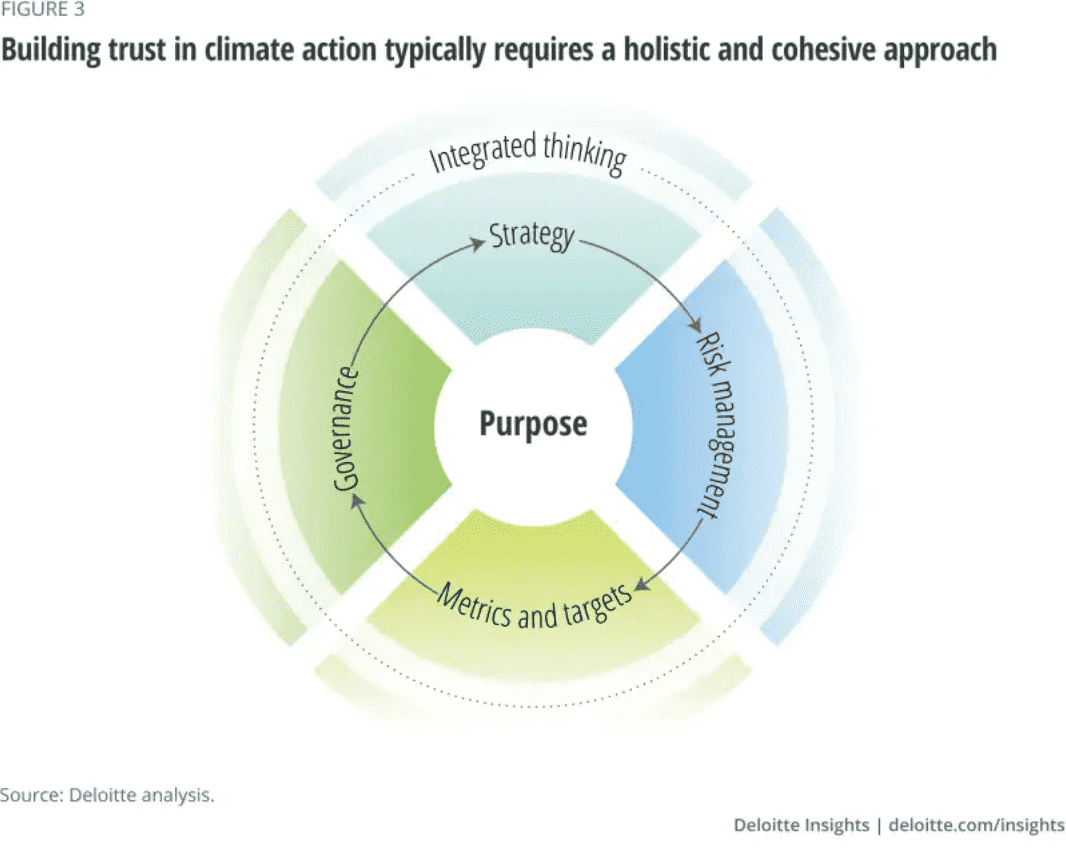With stakeholders leery of greenwashing, how to close the trust gap on leaders’ climate pledges? By making commitments authentic to the organization’s purpose—and fulfilling them.
Closing the trust gap
As the focus on climate change intensifies, companies are increasing their public commitment to fighting it: In 2020, net zero1 pledges tripled over 2019.2 This increasing commitment is driven not only by leaders who want to make a difference but by the growing demands of a wide range of stakeholder groups, from customers and employees to investors, policymakers, and NGOs and activists.
Yet some stakeholders greet public pledges with wariness, skepticism, or outright suspicion. Businesses face a critical trust gap: Consumers and experts alike often struggle to identify which brands truly meet higher environmental standards—and thus, whom to trust.3 The specter of greenwashing, both historical and ongoing, looms over corporate climate actions. This trust gap represents more than a PR failure—it threatens to undermine the progress necessary to address climate change and weaken the resolve of organizations that are taking steps to mitigate their impact on the climate, tempting them to set long-term or vague goals dependent on solutions that do not yet exist when deep and demonstrable progress is needed now.
How can organizations earn trust with their stakeholders when it comes to climate action? Trust can be earned when commitments are authentic to the organization’s purpose and grounded in the organization’s business strategy over time. With that in mind, we offer a road map for organizations to integrate their sustainability considerations into every aspect of the business, whether they are just beginning their journey toward climate stewardship or are well down the road. To understand the market environment with respect to climate commitments, we undertook both qualitative and quantitative analysis, with multiple interviews with chief sustainability officers, advisers, and environmental, societal, and governance (ESG) investment professionals as well as Deloitte leaders and practitioners providing ESG assurance to clients.4
Credible climate commitments are trustworthy. Trust in the enterprise is not an ethereal concept: It can be defined by relationships between an organization and its stakeholders. Trust is understandable and actionable. Organizations build and maintain trust with their workers, customers, community, and others through their actions, performed with competence and intent. Competence is foundational to trust and refers to the ability to execute—to follow through on what you say you will do and live up to your organization’s promise. Intent refers to the reasons or motivations behind your actions, including fairness, transparency, improvement, and impact.5
Building trust, especially across a wide range of stakeholders, requires a thoughtful, proactive, and structured approach. Leaders can build trust throughout their organization through their actions and decisions across operating domains such as customer service, strategic governance, cyber security, and ESG programs.

The trust gap: Why commitments need to be credible
Credible climate commitments can inspire trust in a company and its plan for addressing its carbon footprint. In contrast, organizations that claim to be environmentally friendly but lack a credible plan to support their claims—or, worse, are shown to be hindering climate action—risk accusations of greenwashing.
Greenwashing can lead to multiple negative consequences, including the erosion of trust with stakeholders that may question (possibly rightfully) an organization’s capabilities or intent to reduce its climate impact. This lack of trust can negatively affect the organization in multiple ways, such as increasing the company’s cost of capital, thus reducing valuations and making it more difficult to attract investors.6 Some or more potential partners and consumers may reconsider buying the company’s products and services, and it could become harder to attract and retain top talent who demand that their employers demonstrate commitment to sustainability.7 More broadly, real or perceived greenwashing by peers—and the erosion of trust it engenders—may threaten the allocation of capital toward even climate-forward enterprises. In short, a broken pledge can threaten an organization’s very societal license to operate—or even its actual license to operate or its viability as a business.8 Importantly, research suggests that the inverse is also true with respect to ESG issues broadly: Companies that take significant credible action on material sustainability issues—those considered to significantly affect a company’s financial performance—outperform their competitors.9
And as expectations rise along with urgency, any organization—even one with a solid track record—is vulnerable to losing its stakeholders’ trust. This is true regardless of where a company is in its climate posture. Those organizations with no track record yet, or those seen to be implementing climate efforts to check a box, may be first to receive scrutiny from stakeholders, but even the most committed and advanced are also at risk of losing trust if they are unable to implement necessary plans or ensure appropriate transparency over their efforts—or if expectations increase and they struggle to respond appropriately. Some companies may have sincere intent, wanting to deliver on their climate commitments, but fail to execute. Others may not push for sufficiently ambitious goals. These actions or inaction can weaken stakeholder trust.
There are many examples of companies that might be surprised to be accused of greenwashing. A bank that has invested considerably in its climate commitment program—and is pursuing emissions reductions in alignment with science-based targets—could still come under scrutiny by its stakeholders and in the media for continuing to lend to fossil fuel producers. A clothing company that invests heavily in reducing its carbon footprint and launches an extensive advertising program to promote its sustainability credentials might face criticism after a news story revealing that its largest supplier relies on coal-fired energy.
Just a few years ago, few stakeholders would have questioned these companies’ climate commitments, but as the urgency surrounding climate change intensifies, expectations for corporate climate action are likely to grow. What was once considered sufficient climate action soon could be considered insufficient, potentially placing an organization at risk of being accused of greenwashing if its marketing messages and broader corporate communications, annual reports, and investor presentations are not adjusted to acknowledge higher stakeholder expectations.
Stakeholders’ climate expectations are on the rise
One major obstacle to building credibility with a range of stakeholders: Everyone has their own interests. Different stakeholders evaluate the trustworthiness of a company through the lens of what matters most to them, and climate commitments are no exception. Here we briefly profile some of the expectations, motivations, and influences of four stakeholder groups: investors, customers, employees, and NGOs.10
Investors
For many companies, investors are the most directly influential stakeholder group, and climate change risk is an increasingly significant driver in investment models.11 In a recent survey, institutional investors overwhelmingly (86%) cited climate change as the most significant ESG factor influencing investment decisions; the next-highest factor was a distant 45%. With ESG risks and opportunities driving more investor decisions, expectations are rising for companies across sectors to deliver more robust climate commitments and performance.12 Investors need consistent and credible information regarding an organization’s climate commitments to make decisions. They increasingly expect climate commitments that are science-based and linked to the organization’s core business strategy and decision-making.13 They require that climate-driven risks are presented clearly, that the company’s business model and strategy account for these risks, and that there are comprehensive plans and processes to respond to those risks and achieve stated target greenhouse gas (GHG) reductions in line with the objectives of the 2015 Paris Agreement.14 They also demand transparency and consistent reporting in the company’s overall commitment narrative and financial statements, as well as in nonfinancial disclosures. The latter continue to evolve, especially through the moves by the IFRS Foundation to develop global sustainability standards.15
Investors are motivated to assess and measure the impact of climate change on current and future corporate performance; they need data allowing them to better allocate capital for long-term risk-adjusted returns. Multiple risks exist, including the physical risk to the business due to the impact of climate-driven events such as floods or wildfires as well as the transition risk to the business as the economy decarbonizes and, for instance, fossil-fuel-based resources lose asset value. Investors are also increasingly motivated by the opportunities associated with climate-aware business strategies,16 with ESG-based investments often outperforming more-traditional strategies.17
Influence is being applied both by individual investors, some of whom are taking on activist roles and pushing for stronger climate action, and investor-led initiatives, the latter of which are rapidly growing in size and influence. Climate Action 100+ has so far enlisted more than 540 investors and is engaged across 33 markets, representing more than half of all global assets under management.18 And more than 70 asset managers recently signed a pledge with the Net Zero Investors Initiative, which formed in December 2020; signatories have committed to supporting the goal of net-zero greenhouse gas emissions by 2050 or sooner and include some of the world’s largest asset managers, such as BlackRock and Vanguard.19
A climate commitment that investors judge to be sufficiently credible can build trust not only with the investment community but also with other stakeholder groups; NGOs, regulators, and others pay attention to and take cues from rigorous investor sustainability ratings and assessments.
Consumers and customers
Consumers are often on the receiving end of greenwashing and are less equipped than other stakeholders to gauge compliance or exert pressure.20 But like investors, they are growing increasingly aware of companies’ sustainability commitments and follow through—and as COVID-19 eases, they’re looking for companies to continue pandemic-based progress in reducing their carbon footprint. In one recent study, more than 60% of respondents said that “companies have the opportunity, due to the pandemic, to be more thoughtful about how they incorporate sustainability into their business models moving forward.”21 Enabled by social media and digital communications, consumers can mobilize and turn against a particular brand quickly, which makes it important that companies engender trust in this stakeholder group. While they are less likely to examine the risks of climate change to a company’s business model, they are becoming increasingly cognizant of environmental marketing buzzwords that aren’t prepared in accordance with recognized standards or objective measures.
Consumers increasingly want to purchase products they view as sustainable.22 They also want to believe that their consumption habits won’t negatively affect the environment, and they are fearful of the overall impact of climate change. In an April 2020 study of citizens across 14 countries, with the pandemic spreading, more than 70% saw climate change as a long-term crisis as serious as COVID-19.23 The increasing press and cultural attention to the climate challenge will likely increase consumer focus on the sustainability of specific brands and products.
Scrutiny is hardly confined to consumer-facing businesses. In business-to-business relationships, the focus is rapidly shifting to sustainability performance across the supply chain. Many of these customers are making their own climate commitments, which lead them to develop codes of conduct for their suppliers and monitor risks and performance across their suppliers.
Employees
Employees are an increasingly vocal and expectant stakeholder group across all geographies.24 While workforce activism appears more noticeable for some sectors such as technology, it is expanding.25 Nearly 40% of millennials cite employer sustainability as a factor in deciding where to work; a recent survey shows that seven in 10 US job seekers care at least somewhat about a potential employer’s environmental record.26 In 2019, 85% of employees said they would hold their employers more accountable for their impact on the environment, a 13-point increase from prior year.27
Increasingly, employees of any age want to be part of an organization they see as contributing to the greater good. Many are motivated by a sense of their own purpose as well as by the recognition that climate change poses a risk to the organization and the community. Most also expect organizational leaders to take action.28
NGOs and activists
NGOs and activists, from veteran organizations to young protesters, have a wide range of expectations and approaches to influencing corporate climate action. Some nonprofits such as the World Wildlife Fund and World Resources Institute have operated for decades, partnering with corporations to drive climate action. Other activist organizations may take a more confrontational approach, and, in some cases, stage elaborate events to publicly shame particular companies. Still others use legal action to effect change.29
Whatever corporate leaders’ good intentions, few robust corporate climate actions happen without NGOs’ involvement or influence. The experts we interviewed emphasized how NGOs have been instrumental in setting common benchmarks and standards, providing pathways and best practices toward reducing emissions, and offering objective assessments of progress—or lack thereof. Active engagement with one or more NGOs is increasingly becoming a requirement for credible corporate climate action.
At the same time, an increasingly vocal and influential climate activist community can take some of the credit for pushing climate change to the top of the global agenda.30 Climate strikes and other highly visible actions from various groups have captured global attention and galvanized opinions. Some are well attuned to any effort to greenwash, obfuscate, or distract from actions they see as necessary to avert a climate catastrophe and ensure a just and equitable transition.
Considering stakeholder expectations collectively
Stakeholder pressures are dynamic and evolving. To build and maintain trust in their climate actions, companies need to be ready to respond to issues, both expected and unexpected. Figure 2 offers a summary of the stakeholder groups discussed and their typical motivations and expectations of company climate commitments. While each of these groups is wide-ranging and diverse, and their positions vary, having a general understanding of how the different groups view climate commitments can help companies to tailor and communicate climate actions effectively.

A road map to credible climate commitments: Toward integrated thinking
Building trust in company climate action with the universe of stakeholders is ultimately a journey toward embedding climate considerations into every facet of the organization—in governance, strategy, risk management, and metrics and targets. This shift requires integrated thinking, in which the company’s purpose and consideration for its impacts on the planet, people, and wider economic prosperity are embedded throughout the enterprise.31 Integrated thinking, in short, means infusing sustainability into the core of the business. It requires a holistic and cohesive approach, overseen by the board; it helps companies understand value creation through a new lens that balances short- and long-term outcomes and acknowledges the diverse range of resources—natural, social, and financial—on which all enterprises rely.32
This approach is a process and not a destination. Even if the climate end goal is clear—net-zero emissions globally by 2050—the path there and each organization’s role can continue to evolve, as will stakeholders’ expectations. Adopting integrated thinking means internalizing a recursive process that continually evaluates progress and increases the ambition, always asking: “What more can we do?” Organizations that consider their climate commitments within this dynamic context can engender trust with stakeholders now and build on that trust in the future.
Advancing sufficiently may not be easy, but there are steps that companies can follow as they look to incorporate a broader purpose and care for the climate into their actions—and, in turn, foster trust with stakeholders:
• Set the foundation and commit to action. Understand the organization’s current climate impacts, even beyond its direct and indirect emissions. Companies should also assess other ways they might have influence—for example, via lobbying, services provided, or membership in industry organizations. Evaluate existing reporting practices and identify current and anticipated stakeholder and regulator expectations. Then commit. Leaders should put in place ambitious climate goals that have the visible and vocal support of the C-suite and the board.
• Governance. Create clear ownership and accountability for the organization’s climate commitments. Ensure that the board is appropriately educated and informed, and champion the effort from the C-suite. Ensure that a senior executive is empowered to drive the necessary changes. Establish concrete metrics at the business unit, geography, and individual level where appropriate, and incentivize climate action by embedding it in performance management and remuneration policies.
• Strategy. Develop goals with appropriate focus and targets that embody the characteristics of the most robust climate commitments (see sidebar, “Creating robust climate commitments”). Take an enterprise view of the company’s climate impacts and align goals with the scientific consensus about what’s needed. Working with third-party organizations such as the Science Based Targets Initiative can add additional rigor and credibility to goal-setting efforts. To that end, ambitious long-run targets will likely be needed, but also focus on near-term (one-year, five-year) goals with firm emissions reduction objectives. Then craft a strategy for how to get there. Identify the levers at the organization’s disposal and be willing to transform every part of the business—operations, supply chains, talent, IT, and beyond. Depending on the business, there may be opportunities for product or service innovation across the value chain, incorporating clean technology and circular processes. Successful execution might require new capabilities (or the shedding of legacy ones), so M&A and divestiture options should be considered.
• Risk management. Understand the external environment and the expectations of stakeholders. Take a comprehensive view of potential risks, including physical and transition climate risks and reputational risks. For companies with a wide geographic footprint, it is important to also understand how risks and expectations could vary across geographies and the value chain—and how those risks might affect the business overall. Climate-related risks should be embedded into the overall ERM process, not viewed as separate or standalone.
• Metrics and targets. Align reporting to leading third-party standards and frameworks (for example, the Taskforce on Climate-Related Financial Disclosure and the Sustainability Accounting Standards Board), keeping apprised of the fast-moving evolution of metrics and harmonization efforts (for example, the World Economic Forum and its International Business Council’s work on Stakeholder Capitalism Metrics). Major efforts are underway toward rationalization and the creation of an authoritative standard-setting body under the umbrella of the IFRS Foundation.33 To enhance the process, undertake benchmarking against peers to select industry-comparable metrics. Integrate sustainability and climate measures into the internal audit plan and evaluate the type and level of external assurance required to meet stakeholder expectations.
There is no universally agreed-to rule for what constitutes a “sufficient” corporate climate commitment. But climate commitments should generally display several key attributes:
Comprehensive scope. They encompass as much of the organization’s climate impact as possible. That includes not only Scope 1 and 2 emissions—direct emissions from operations or from purchasing electricity, for example—but, increasingly, Scope 3 sources derived from supply chains and product end use.
In fact, they take a holistic view of the climate implications of all the enterprise’s activities at every link of the value chain, and even beyond to consideration of what the company’s activities might be funding or facilitating. Depending on the business, the breadth of a leading climate commitment might also extend far beyond the organization’s carbon footprint—indeed, for many companies, direct emissions likely pale in comparison to the climate impacts of other aspects of their business. Banks should apply an equally rigorous lens to their lending portfolios, just as services firms should consider who their clients are and what types of work they are doing on their behalf. Leaders should scrutinize policy advocacy, political contributions, and the actions of trade and industry associations with which the company affiliates through a climate lens.
Science-based targets. They are aligned with the scientific consensus and consistent with pathways that could limit warming to 1.5°C, as outlined in the Paris Agreement. Net zero by 2050, in which no more emissions are produced than are removed from the atmosphere, is increasingly the benchmark based on the goals set out in the most recent Intergovernmental Panel on Climate Change report.34 That said, the best plans aim to front load emissions reductions in the next decade or less—and put forward clear mechanisms for achieving those targets.
Targets should focus on the most important outcome for addressing climate change—reducing absolute GHG emissions—rather than relative emissions intensity or other measures that too often mask actual increases in GHGs over time. And they should rely on carbon offsets to the least extent possible. (There are uncertainties about how net zero translates to the level of the organization and exactly how much of a role purchased carbon credits can count toward a credible net-zero commitment. The Science Based Targets Initiative is currently leading an effort to better define what constitutes a corporate net-zero target.35)
Rigorous assurance. Performance is assurable and sufficiently comprehensive and rigorous to meet the objectives of the Science Based Targets Initiative. Climate commitments should be transparent, with companies disclosing detailed data about their current and past emissions and committing to reporting on progress regularly. Climate and other ESG data should be capable of being assured by third parties that follow leading standards.
While commitments that reflect these three attributes might be considered leading practice, they represent the bare minimum of what is needed if we are to truly limit catastrophic climate change.36 Today, only a small fraction of businesses’ commitments exhibit these characteristics. Additionally, four-fifths of the 2,000 largest global public companies have set no net-zero emissions target,37 and only four of the 10 largest US companies have an announced plan to reach net zero by 2050.38

Forging credible climate commitments
The landscape of climate commitments is shifting rapidly as society and institutions accelerate their response to the urgency of the climate crisis. Building trust with key stakeholders requires both credible plans and milestones toward achieving net-zero goals and measuring and communicating progress. A trust gap can be created when companies commit to long-term targets decades away but don’t establish or communicate a strategy for action.
Credible and authentic climate commitments are possible when the business embraces integrated thinking and embeds climate and ESG in its DNA. Such credible actions support credible commitments.
The good news: Organizations that recognize the importance of integrated thinking and develop credible carbon reduction strategies can build trust with their stakeholders and may be better positioned to seize opportunities that emerge in the transition to a low-carbon economy. Establishing credible commitments is among the initial steps to thrive in a net-zero economy. This is a journey that takes time but comes with increasing urgency. Now is the time to accelerate progress.
- “Net zero” refers to a point at which no more greenhouse gases are emitted than are removed from the atmosphere. View in Article
- Data-Driven EnviroLab and NewClimate Institute, Accelerating net zero: Exploring cities, regions, and companies’ pledges to decarbonize , September 2020.View in Article
- Alden Wicker, “The flawed ways brands talk about sustainability ,” Vogue Business, April 16, 2020; Patrycja Gautier, Getting rid of greenwashing: Restoring consumer confidence in green claims ,” European Consumer Organisation, February 12, 2020. View in Article
- Analysis was conducted using the climate commitment database from Science Based Targets Initiative, American University’s climate action tracker, Deloitte’s 2021 Global Resilience survey, and 2021 Millennial survey. View in Article
- Punit Renjen, The value of resilient leadership: Renewing our investment in trust , Deloitte Insights, October 8, 2020. View in Article
- Audrey Choi, “Why sustainable companies can outperform,” Morgan Stanley, December 4, 2017. View in Article
- Andrew Winston, “Leading a new era of climate action,” Harvard Business Review, January 23, 2020. View in Article
- Ellen Gilmer and Bob Van Voris, “NYC sues Exxon, Shell, BP over ads calling products ‘cleaner’,” Bloomberg, April 22, 2021. View in Article
- Mozaffar Khan, George Serafeim, and Aaron Yoon, “Corporate sustainability: First evidence on materiality,” Harvard Business School, March 2015; George Serafeim, “Social-impact efforts that create real value,” Harvard Business Review, September 2020. View in Article
- We don’t discuss compliance activity with government or regulatory stakeholders here. While emerging regulations and policies are deeply relevant, we suggest that organizations that build credible climate commitments with investors, consumers, employees, and NGOs are likely to be well-positioned to respond to shifting government and regulatory expectations. View in Article
- Deloitte, Creating a climate of change: Addressing the business ramifications of climate risk on banks, 2020. View in Article
- Kiran Vasantham and David Shammai, Institutional investor survey 2020, Morrow Sodali, 2020. View in Article
- Larry Fink, “Larry Fink’s 2021 letter to CEOs,” January 26, 2021. View in Article
- IIGCC, “Investor expectations for Paris-aligned accounts,” November 16, 2020. View in Article
- IFRS Foundation, “IFRS Foundation trustees announce strategic direction and further steps based on feedback to sustainability reporting consultation,” March 22, 2021. View in Article
- Tensie Whelan et al., “ESG and financial performance: Uncovering the relationship by aggregating evidence from 1,000 plus studies published between 2015–2020,” Rockefeller Asset Management and NYU Stern Center for Sustainable Business, February 2021. View in Article
- Siobhan Riding, “Majority of ESG funds outperform wider market over 10 years,” Financial Times, June 13, 2020. View in Article
- Climate Action 100+, “About,” accessed May 10, 2021. View in Article
- Ross Kerber, “Investors BlackRock, Vanguard join net zero effort,” Reuters, March 29, 2021. View in Article
- Mariusz Urbański and Adnan ul Haque, “Are you environmentally conscious enough to differentiate between greenwashed and sustainable items? A global consumers perspective,” Sustainability 12, no. 5 (2020). View in Article
- Porter Novelli, “PN purpose tracker: COVID-19 & climate special,” July 2020. View in Article
- Katherine White, David J. Hardisty, and Rishad Habib, “The elusive green consumer,” Harvard Business Review, July–August 2019. View in Article
- Emily Gray and Chris Jackson, “Two thirds of citizens around the world agree climate change is as serious a crisis as Coronavirus,” Ipsos, April 22, 2020. View in Article
- Herbert Smith Freehills, “Future of work: Adapting to the democratised workplace,” December 2, 2019. View in Article
- Louise Matsakis, “Thousands of tech workers join global climate change strike,” Wired, September 9, 2019. View in Article
- Adele Peters, “Most millennials would take a pay cut to work at an environmentally responsible company,” Fast Company, February 14, 2019; Justin McCarthy, “Environmental record a factor for most U.S. job seekers,” Gallup, April 13, 2021. View in Article
- Environmental Defense Fund, Business and the fourth wave of environmentalism, 2019. View in Article
- Sarah Sax, “Employees are fighting for a new cause at work: The climate,” Huffington Post, April 27, 2020. View in Article
- ClientEarth, “About,” accessed May 10, 2021. View in Article
- Dana R. Fisher and Sohana Nasrin, “Climate activism and its effects,” WIREs Climate Change and Wiley, September 21, 2020. View in Article
- Paul Dobson, “Integrated thinking powers better business reporting,” Deloitte, May 6, 2019. View in Article
- Partha Dasgupta, The economics of biodiversity: The Dasgupta review, Gov.uk, April 23, 2021. View in Article
- World Economic Forum, Measuring Stakeholder Capitalism: Towards Common Metrics and Consistent Reporting of Sustainable Value Creation, September 22, 2020; IFRS, “IFRS Foundation trustees announce working group to accelerate convergence in global sustainability reporting standards focused on enterprise value,” March 22, 2021. View in Article
- Intergovernmental Panel on Climate Change, Global warming of 1.5 ºC, October 8, 2018. View in Article
- Science Based Targets, “Net-zero,” accessed May 10, 2021. View in Article
- Intergovernmental Panel on Climate Change, Global warming of 1.5 ºC. View in Article
- Jack Graham, “Net-zero emissions targets adopted by one-fifth of world’s largest companies,” Reuters, March 24, 2021; Deloitte’s 2021 resilience survey agrees: Less than one-fifth of C-suite executives said their organizations have a plan in place to be carbon-neutral by 2050—see 2021 Deloitte global resilience report. View in Article
- Tim Quinson, “Tech companies are setting the most ambitious net-zero goals,” Bloomberg Quint, April 7, 2021. View in Article
The authors would like to thank Karen Werger, Scott Corwin, Daniel Markham, Caitlyn Yu, Michael De Ciantis, Della Wang, Brenna Sniderman, Charlotte Drain, Natasha Fortuin, Sam Baker, Negina Rood, Melinda Nowak, and Matthew Budman for sharing valuable insights contributing to the development of this article.
The article was first published here.
Photo by Marek Piwnicki on Unsplash.

 5.0
5.0 





















